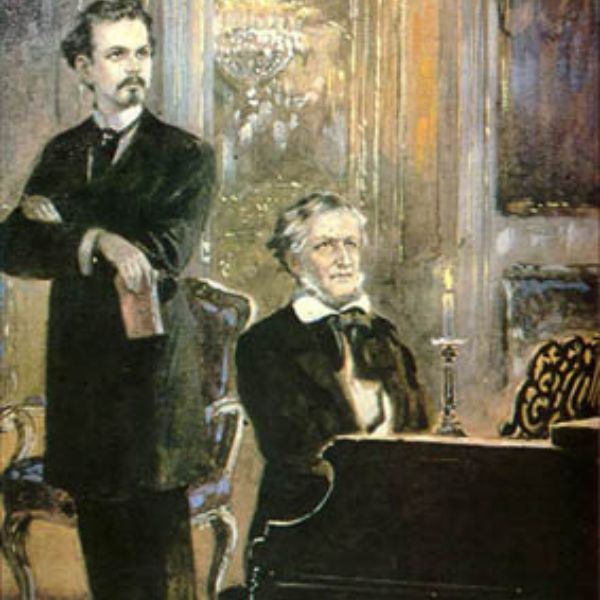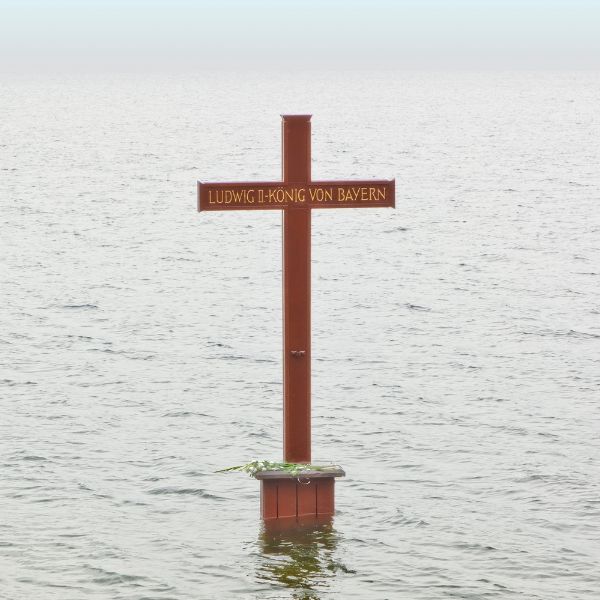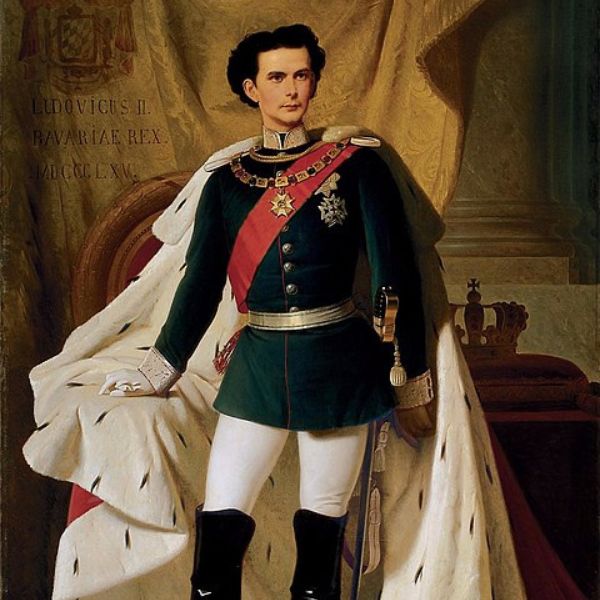- Home
- King Ludwig
King Ludwig II of Bavaria
By: Lydia Fulson / Writer, Pyrography Artist, Thrill Seeker, and Traveler
The man and the legend himself, King Ludwig II of Bavaria, went down in German history as a whimsical and fantastical lover of all things costly. He was the mastermind behind some of Germany's most famous castles, including Neuschwanstein Castle of the Bavarian Alps, which inspired Walt Disney.
This and his other future castle and palace builds led to his Der Märchenkönig ('the Fairy Tale King') nickname. Just wait until you get a glimpse of those! He was also nicknamed the Mad King. But was he, or was he just an eccentric man with an imagination frowned upon by traditional men?
Young Ludwig, the Crown Prince Ludwig, became 'Crown King' very early on after his father, King Maximilian II, passed due to an illness in 1864. He was only nineteen years old when handed the great responsibility. But he was not the dream king his family sought him to be.
He had an eye for art – a good one! He was fascinated with architecture, Baroque, Renaissance, and Gothic styles to name a few, that inspired the design behind his castles.
On this page:
A journey into the past
Ludwig had a lonely childhood, leaving him to his imagination. His relationship with his parents was rocky, and his brother Otto was fairly distant. He had a much closer one with his grandfather, who fully accepted him as he was.
With royal responsibilities comes great expectations, and Ludwig wanted no part in any of it. He enjoyed the time he spent visiting castles throughout Bavaria with his father, like his own Hohenschwangau Castle on occasion and enjoyed his leisurely garden strolls with his dearest friend.
Starting at a very young age, he would often be caught by his servants speaking to imaginary friends, and his time alone led him to his love for the arts and opera. Ludwig had a deep passion for the operas of Richard Wagner. In fact, his castles were built with stages specifically for watching Wagner's operas! Now, that's passion.
He became close with his assistant, Prince Paul, and spent hours reading and reenacting plays and taking trail rides on horseback together. But holding a friendship together when both were dealing with such high expectations and duties, their friendship dwindled with time, eventually becoming non-existent after Paul married a commoner. Nothing lasts forever when you live so lavishly.
A glimpse into royal life
Let's admit it: we all would be excited about the lavish parties if we could spend a day as royalty. But growing up in a royal family is much more than getting dressed up and dancing the nights away while sipping fancy cocktails.
It's important meetings, affairs of state, chats about the German war, and preparing for the worst. It's burden after burden, after responsibility, and there's no time for fun, especially after a grave decision.
The occasional family affair or fun day out with a friend would often lead Ludwig into a profound argument with his family about handling responsibilities above all else.
But the young fairytale King had bigger plans for his life, which filled his family and fellow royals with rage. Ludwig's mother knew from a young age that he would be a handful, calling his artistic dreams and ways preposterous.
His family would have to apologize to their friends and colleagues for their son's continuous absence from public life. He may have been the King Ludwig II of Bavaria, but he certainly didn't want to be seen by Bavaria. Ludwig would rather be reading, drawing, or his favorite, reading and watching his all-time favorite operas.
The operas' impact
It was never any secret to his family that Ludwig adored opera, specifically those of writer and composer Richard Wagner, like the Der Ring des Nibelungen, the four-part musical, and Die Meistersinger opera, which became a massive hit! He would recite the operas and put on plays for his family, even with their uncaring attitudes.
Neglectfully, he would run off and watch operas instead of being present for royal duties. Who wants to sign papers and have snooze-fest conversations when you can reenact songs and dramatically read lines?
Ludwig's true relationship with Wagner will never be completely known, but they were close. Ludwig even saved his career from going down the drain. The famous opera composer was becoming less famous with time. When Wagner was able to meet with the King, they clicked, having such similarly creative minds. Wagner even wrote about how beautiful and tragic King Ludwig II of Bavaria's life was.
 The two buddies sharing their love for composing
The two buddies sharing their love for composingThanks to this, Wagner's fame skyrocketed again. The two would get together and compose. But one day, this all came crashing down when he released an opera that the public saw as way too scandalous, and Wagner was banished from the city.
This, of course, was heartbreaking for the King. What made it worse was that HE was the one who had to banish him.
It's not for sure, but it is a theory that this contributed to his descent into madness.
He continued to keep in contact with Wagner, even after his banishment, and even paid for him and his family to have somewhere to stay. He also contributed money for him to pursue his opera writing and creating in his new home in Switzerland, and would meet for private performances. Acts like these are what the King wanted to contribute to. Not to the royal decrees, but to help those like him with a passion and a dream.
The descent into costly madness
Costly, indeed.
After this spiral of a relationship with Wagner, Ludwig's mental state grew even more worrisome.
Losing his friends and family relationships took a toll on him. And what's the one thing you can turn to when you're rich?
Money, money, money!
But he didn't spend his money on clothing and fancy dishes. His fortune was spent creating castles and palaces. Ludwig developed a love for castles at a very young age. After all, he spent his life living in one. Nymphenburg Palace was his humble abode for a large part of his life. It's also where his father, Maximilian, passed.
First was his fantasy castle, Neuschwanstein, his dream castle of more than 200 planned rooms and towering architecture over the Bavarian cliffsides. This was only four years after he took the crown.
 Well, that's one way to spend your money!
Well, that's one way to spend your money!It's by far the most popular of Ludwig's castles, not just for the thousands of tourists it brings, but to Germany itself. The great Neuschwanstein Castle was even featured on the two-euro coin in 2012.
The Bavarian people were outraged when they discovered that the king was blowing so much money on something so useless to the public. But were they completely shocked? ... Probably not.
He named his next building, The Linderhof Palace. He took its inspiration from the Palace of Versailles, featuring spunky colors and chandeliers worth millions.
If you think that's a hefty price tag, imagine how the Bavarian people felt when they found out that Ludwig had spent US$250,100,000 (€230,517,170.00) on his third build, Herrenchiemsee Palace, which also took Versailles inspiration. The crazy part? Not all of it was money from his pocket. He asked his parents to help fund the buildings.
See Castles in Bavaria to learn more about his 'Replica of Versailles' with its famous hall of mirrors, and the other expensive palaces of King Ludwig II of Bavaria.
What's sad is that he didn't live long enough to see them all in their finished stages.
The fall of the king
The fall of King Ludwig II of Bavaria is nothing short of a mystery. But, of course, there are ideas and conspiracies. His downfall started after the castle-building spree.
His carelessness with spending and his attitude towards his royal duties concerned his servants. He was always very kind towards them, but his newfound reckless behavior left him and his family in debt. The people of Munich came to an agreement that he had to go.
They declared him mad for his eccentric actions and neglect of royal duties. He was given a deposition letter in 1886 and taken into custody at Berg castle.
 King Ludwig's memorial cross marking the spot that his body was found in Lake Starnberg.
King Ludwig's memorial cross marking the spot that his body was found in Lake Starnberg.Only one day later would the lifeless body of the mad king be found floating in Lake Starnberg under mysterious circumstances. How'd he end up there? The bigger mystery is that his psychiatrist, Dr. Gudden, was found floating right next to him.
The last recorded sighting of the two men was when Gudden asked to take a walk and requested not to have any guards follow. One conspiracy theory is that Ludwig and Gudden argued during a walk they took together in the gardens of the Berg, and someone snapped.
Ludwig's medical report showed no signs of drowning, and he was an exceptionally strong swimmer. So, the theory of Gudden trying to drown him was ruled out. Other conspiracies say that he strangled the doctor, tried escaping into the lake, and was shot in the water. But there were no scars, wounds, or signs of this. The only plausible cause seemed to be a natural one, like hypothermia or a heart attack, but it will always be a mystery lost in history.
The throne was not left empty after the circumstances of his death. Ludwig's younger brother bumped up the royal ladder to take his rightful place as king, becoming King Otto of Bavaria. But with a flashback to before all the drama, Otto was diagnosed as mentally ill by Dr. Gudden years prior. When this came to light, he was made to take a break from royal duties for a while. Nevertheless, he still called himself the loyal King of the lovely Bavaria.
King Ludwig II of Bavaria lives on
Though his time was short, the dramatic life of King Ludwig II of Bavaria turned heads and certainly grabbed people's attention. His memorial at Lake Starnberg is visited often, and millions visit his castles. There is so much history, tragedy, love and inspiration in his story.
No one truly knows how things in his life panned out as they did, but he left an impact. Whether he went out either in a blaze of glory or peacefully and naturally, he lived life HIS way. His wild legacy lives on in his castles and magnificent palaces, and his story, while it may be full of holes, will live on just as strong.

